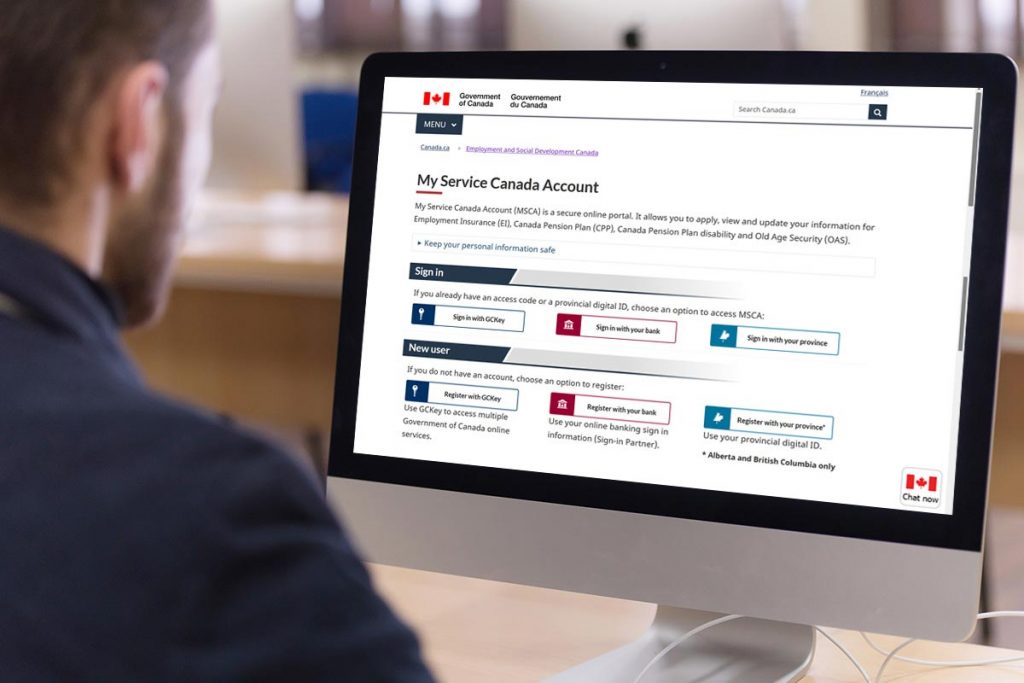Last Updated on April 13, 2025

Hey, there! It is likely that you have arrived here with the intent of gaining an understanding of the foundational steps involved in registering for a My Service Canada Account (MSCA) or seeking a review of the process for accessing your account. This article is specifically designed to address your needs. Let’s get started.
First things first, What is it? My Service Canada Account (MSCA) is a secure online platform established by the Canadian government. Through this portal, individuals are able to access comprehensive information pertaining to their government benefits, which will be further elaborated upon in the following content.
For new immigrants or those planning to reside in Canada, registration for My Service Canada Account (MSCA) is a mandatory requirement that will eventually need to be fulfilled. It is important to note that compliance with this requirement is non-negotiable.
| QUICK LINKS | |
|---|---|
| What Can I Access or Do in MSCA? | How to Register for My Service Canada Account |
| How Can I Access My Service Canada Account? | How to Login for My Service Canada Account |
What Can I Access or Do in MSCA?
It is worth noting that by obtaining a My Service Canada Account (MSCA), individuals have the ability to apply for, view, edit, and update personal information related to various government benefits such as Employment Insurance, Canada Pension Plan, Canada Pension Plan Disability, Old Age Security, and Tax information. This feature serves as a valuable asset and should be given due consideration. We encourage you to continue reading for further details.
Employment Insurance (EI)
Employment Insurance (EI) is a government benefit designed to provide financial assistance to individuals who experience temporary or permanent job loss through no fault of their own, such as due to shortage of work or seasonal or mass lay-offs, and who are available and able to work, but unable to secure employment. Application for EI benefits can be initiated as soon as an individual stops working. This EI benefits article provides a more in-depth explanation of Employment Insurance and its benefits.
Canada Pension Plan (CPP)
The Canada Pension Plan (CPP) is a government-administered retirement pension program. It provides a monthly, taxable benefit that is intended to supplement income during retirement. Eligible individuals will receive the CPP retirement pension on an ongoing basis for the remainder of their lives. To learn more information with comprehensive explanation of the Canada Pension Plan benefits click here.
Canada Pension Plan Disability
The Canada Pension Plan Disability (CPP-D) is a government benefit program intended to provide financial support to individuals who are CPP contributors and are no longer able to work due to personal illness or severe injury. Payments are made to eligible individuals until they reach the age of 65.
Old Age Security (OAS)
Old Age Security (OAS) is a government-funded universal retirement pension program that is made available to a majority of residents and citizens of Canada who have reached the age of 65. For detailed information about OAS benefits, visit this page.
Did You Know…
- that My Service Canada Account (MSCA) allows you to conveniently access and manage various federal services online, including Employment Insurance (EI), Canada Pension Plan (CPP), and Old Age Security (OAS) benefits, all from one secure platform.

How Can I Access or Login in My Service Canada Account?
Hold on. Do not overthink, you’re done before you know it! Take it slow!
As a new user, there are three options available for registering for a My Service Canada Account (MSCA). These include registration through the use of a GC Key, registration through a financial institution, and registration through a provincial government agency. The step-by-step procedures for each option will be discussed in the following content.
STEP 1: Visit My Service Canada Account login page
STEP 2: If you are an existing user click on any of the sign options below:
- Option 1 – Sign in with the GCKey
- Option 2 – Sign in with your bank
- Option 3 – Sign in with your province digital ID (Alberta Only)
If you are a new user, you will need to register:
- Option 1 – Register with the GCKey
- Option 2 – Register with your bank
- Option 3 – Register with your province digital ID (Alberta Only)
I’m a New User:
How to Register for My Service Canada Account
As a new user, there are various methods for registering for a My Service Canada Account (MSCA). These include utilizing the GCKey, registering through a financial institution, and registering through a provincial government agency. Each of these options will be thoroughly examined in the following content.
Option 1: Register with the GCKey
A GCKey is a unique electronic access (e-access) issued by the Government of Canada for use with multiple online Government services (e-services). To use GCKey to access MSCA you must:
- A GCKey ID
- A Personal Access Code (PAC)
1. Request a Personal Access Code (PAC)
A Personal Access Code or simply PAC is your key to accessing secure online services. You need to have an access code before you can register for MSCA with GCKey.
You will need the following:
- Social Insurance Number (SIN)
- Parent’s family name at birth
- Postal code if you are a Canadian resident or your country of residence if you are a foreign resident
2. Receive PAC
Service Canada will provide you with an access code. You need this code to register for MSCA. If you apply online, you will receive it by mail within 5 to 10 business days.
3. Sign up for GCKey (skip this step if you have your GCkey)
GCKey is required to access multiple Government Canada e-Services, if you don’t have it yet – now is the time to sign up.
- Sign up for a GCKey user ID and password if you do not have one.
- If you have forgotten an existing GCKey user ID you will need to create a new one.
4. Register for MSCA with your GCKey
You will need the following:
- Personal Access Code (PAC)
- Social Insurance Number (SIN)
Option 2: Register with your Bank
To use your bank institution (Sign-in Partner) to access MSCA you must have:
- A verified Sign-in Partner
- An access code either EI Access Code (AC), or Personal Access Code (PAC)
Access codes are used to help validate your identity for MSCA and keep your account secure.
- Determine if your bank is a verified Sign-in Partner.
- Request access code. An access code is your key to accessing secure online services. You need to have an access code before you can register for MSCA with GCKey.
- Receive access code – Service Canada will provide you with an access code. You need this code to register for MSCA. If you apply online, you will receive your access code by mail within 5 to 10 business days.
- Register for MSCA with a verified Sign-in Partner.
Option 3: Register with your province digital ID
If you’re from Alberta and British Columbia you only need your DIGITAL ID to log in. If not, follow Option 1 or 2.
This service is only for Alberta and British Columbia at this time.
Did You Know…
- that MSCA provides easy access to your personal tax information, allowing you to view and print your tax slips and manage your contributions and benefits seamlessly. This makes tax filing and financial planning much more efficient and hassle-free.

I’m an Existing User:
How to Login for My Service Canada Account
Similar to the registration process for new users, there are various methods for logging into an existing My Service Canada Account (MSCA) for existing users. These include utilizing the GCKey, registering through a financial institution, and registering through a provincial government agency. Each of these options will be thoroughly examined in the following content.
Option 1: Sign In with the GCKey
To log in, simply enter the necessary username and password. If you do not possess a GCKey, it is necessary to register for one as part of the My Service Canada Account (MSCA) registration process. In the event that a user forgets their existing GCKey user ID, it will be necessary to create a new one.
Option 2: Sign In with your Bank Partner
- To sign-in simply go to the Secure Key Concierge area
- Next is to select your Bank Sign-In Partner from the choices
- Then submit to enter to your account and access it.
Option 3: Sign In with your province digital ID
As of this time, This option is only available for Alberta and British Columbia residents.
If you’re from Alberta and British Columbia you only need your DIGITAL ID to log in. If not, follow Option 1 or 2.
Conclusion
Your My Service Canada Account is a valuable resource that provides you with convenient access to essential government services. With it, you can manage your Employment Insurance (EI) benefits, keep track of your Canada Pension Plan (CPP), apply for Old Age Security (OAS) benefits, and conveniently access your Social Insurance Number (SIN) information. This one-stop portal streamlines your interactions with key programs and services, making it easier than ever to navigate and access Canada’s benefits and ensure you receive the support you need.
Make the most of your My Service Canada Account to stay informed, access your benefits, and plan for a secure financial future.






